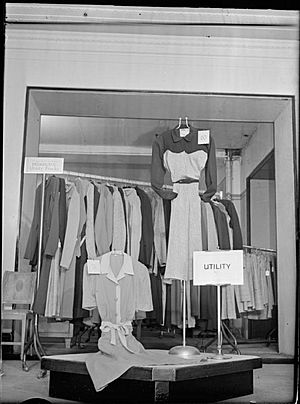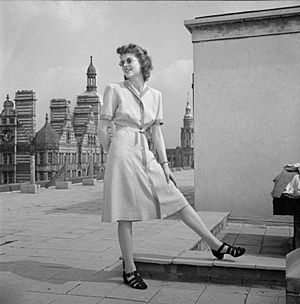Utility clothing facts for kids
The Utility Clothing Scheme was a special plan started in the United Kingdom during World War II. Because of the war, there wasn't enough fabric or workers to make clothes. So, the government's Board of Trade created this scheme. It helped control how clothes were made, sold, and bought during wartime. The plan made sure everyone could get clothes and shoes, no matter how much money they had.
Utility clothing had to follow strict rules about how much material could be used. This was part of the clothes rationing system at the time. Utility clothing, and later Utility furniture, had a special tag called CC41.
Some people worried that these new rules would make clothes look unfashionable. To fix this, famous designers, like Hardy Amies and Norman Hartnell, were asked to create designs for Utility clothes in 1942. The Utility Clothing Scheme ran from 1941 until 1952.
What Was Utility Clothing?
During World War II, it was hard to get raw materials like fabric. This meant there were fewer clothes for people to buy. Prices went up, and some materials, like silk, became impossible to find.
Clothes rationing started in Britain on June 1, 1941. To buy clothes, people needed both money and special coupons. But even with rationing, some people still found it hard to get clothes. People were trying to get the most out of their coupons, which made clothing costs very high. The Utility Clothing Scheme was put in place to help with this problem.
In September 1941, the government began to set rules for clothing. They announced that special fabric would be made for "general utility" clothing. This fabric and the clothes made from it would have the official CC41 mark. The government would control the prices, making sure people could afford good quality clothes.
The Utility Clothing Scheme allowed the government to control supplies of raw materials. Saving materials like cotton, wool, and leather was important because they were scarce. Factories that made Utility clothing had to produce a certain amount. They had to make 85% of their total clothing as Utility items. The Board of Trade allowed the remaining 15% for non-utility clothing.
The clothing industry was encouraged to make limited items. This helped meet people's needs and reduced the number of choices for buyers. Utility clothes had fixed prices. This made sure that people could buy good quality clothes that would last a long time.
So, the Utility Clothing Scheme aimed to control prices. It also regulated how clothes were made and sold. It made sure that strong, long-lasting clothes were available across Britain. Even with rules and limited materials, designers made many styles and colors of Utility clothing. The scheme helped produce fashionable clothes throughout the war and even after.
The 'CC41' Mark
The CC41 mark was put on all Utility fabric, clothes, shoes, furniture, and home items. It could be a label, printed, or stamped mark. People sometimes called the symbol "cheeses." It was designed by Reginald Shipp in 1941. The mark stood for "Civilian Clothing 1941."
Utility Shoes
The Utility Clothing Scheme also included shoes. Utility shoes came in many different designs. The materials used to make them were controlled. However, their style was not standardized, except for the heel height. Heels could be no taller than two and one-eighth inches. Heels had to be made from wood. Utility shoes also had a leather top part. Open-toed shoes were only allowed to be made after 1947.




